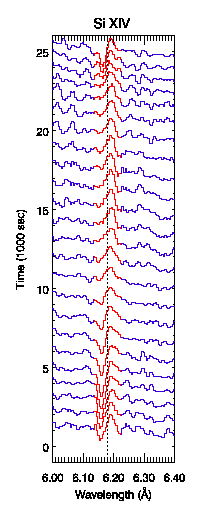 |
The HETGS has logged about one-and-a-half years of consistant operation and performance thanks to the excellence and stability of the HRMA, HETG, ACIS, and spacecraft operations. There are some new and updated documents and software for use with the HETGS as described further below. However the real news around the HETGS is the observations it has been making, some of which have ``gone public" and are available from the Chandra data archive [1].
 |
With its initial observations of Capella, the HETGS proved its ability to do high-resolution spectroscopy, clearly revealing and measuring the narrow lines in this point source (e.g., ObsID 1103.) Almost immediately, however, the HETGS was used to observe an object with substantial velocity structure in its emission, SS 433 ([2]; ObsID 106.) Figure 2 clearly shows red- and blue-shifted lines of Fe XXV, a He-like ion as well as neutral Fe emission at the rest wavelength. The widths and Doppler shifts of the all emission lines in the full HETGS spectrum are consistent, indicating that the ionized material is in a uniform outflow of constant velocity and opening angle.
An even more complex example of the effects of velocity are seen in
the HETGS spectra of the of the low mass X-ray binary Circinus X-1 ([3];
ObsID 1700.) Shown in Figure 3 is the first instance ever found
of an X-ray ``P Cygni profile" produced by a massive, highly dynamic
outflow. The time profiles for the Si XIV Lyman ![]() line are
from a 5 ks window of data with the start time progressively shifted
by 1 ks; clear changes in the profile are seen on scales of hours.
The peak to valley wavelength differences in the full spectrum
correspond to velocities of order 1000 to 4000 km s-1.
line are
from a 5 ks window of data with the start time progressively shifted
by 1 ks; clear changes in the profile are seen on scales of hours.
The peak to valley wavelength differences in the full spectrum
correspond to velocities of order 1000 to 4000 km s-1.
 |
The HETGS has been used for multiple-point sources as in the observations of the bright young stars in the Trapezium ([4]; ObsIds 3 and 4.) However, the most complex regeime of HETGS observations are extended sources with significant, spatially-dependant emission velocities, e.g., the super nova remnant E0102-72 in the LMC ([5]; ObsIds 120, 968.) In these observations, coherent velocities of order 1,000 km s-1 are directly measured through their effect on the diffracted images, similar to the simple example diagramed in the POG [6], section 8.5.3.
Updated information and discussions of several aspects of the HETGS calibration are discussed in the new POG [6], including: the cross-dispersion profile, background spectra, absolute wavelength, and effective area. The properties of the HETGS are now described by specifically named files in the Chandra Calibration Database [7]. These files are then used by CXC software to create well-defined calibration files for analysis, e.g. mkgarf creates observation-specific ARF files. For up-to-date information on the HETGS calibration, see the HETG link in the Chandra Instruments and Calibration page [8.]
With the existence of HETGS and LETGS high-resolution spectra there is a market for spectral analysis tools tailored to these data. In addition to XSPEC there are at least three packages in new or recently updated forms available to users. ``Guide" is part of the CXC CIAO 2.0 release [9]; ``ISIS" from CXC/MIT is a more stand-alone package [10]; and ``PINT of ALE" from SAO's Drake and Kashyap is an IDL-based package [11]. Community experience and usage of these and other software are bound to produce an evolution and creation of new packages as the richness of the grating-dispersed data is fully mined.
[1]Chandra data archive page: http://cxc.harvard.edu/cda/
[2]SS433 paper: Marshall, Canizares and Schulz, ApJ (submitted)
[3]Circinus X-1 page: Brandt W.N., Schulz N.S., 2000, ApJ, 544, L123-L127
http://www.astro.psu.edu/users/niel/cirx1/cirx1.html
[4]Trapezium paper: Schulz et al., ApJ(accepted); http://xxx.lanl.gov/abs/astro-ph/0011366
[5]Initial Results from the Chandra High Energy Grating Spectrometer, Canizares et al., in Atomic Data Needs for X-ray Astronomy: Proceedings, M. A. Bautista, T. R. Kallman, A. K. Pradhan, ed.s, 1999;
http://heasarc.gsfc.nasa.gov/docs/heasarc/atomic/ps/canizares.ps
[6]Chandra proposers' observatory guide, Rev 3.0 December 2000:
http://cxc.harvard.edu/udocs/docs/docs.html
[7]Chandra calibration database page:
[8]Chandra instruments and calibration page:
[9]CIAO and Guide page:
[10]ISIS web page:
http://space.mit.edu/ASC/ISIS/
[11]PINT of ALE web page:
http://hea-www.harvard.edu/PINTofALE/
- Dan Dewey